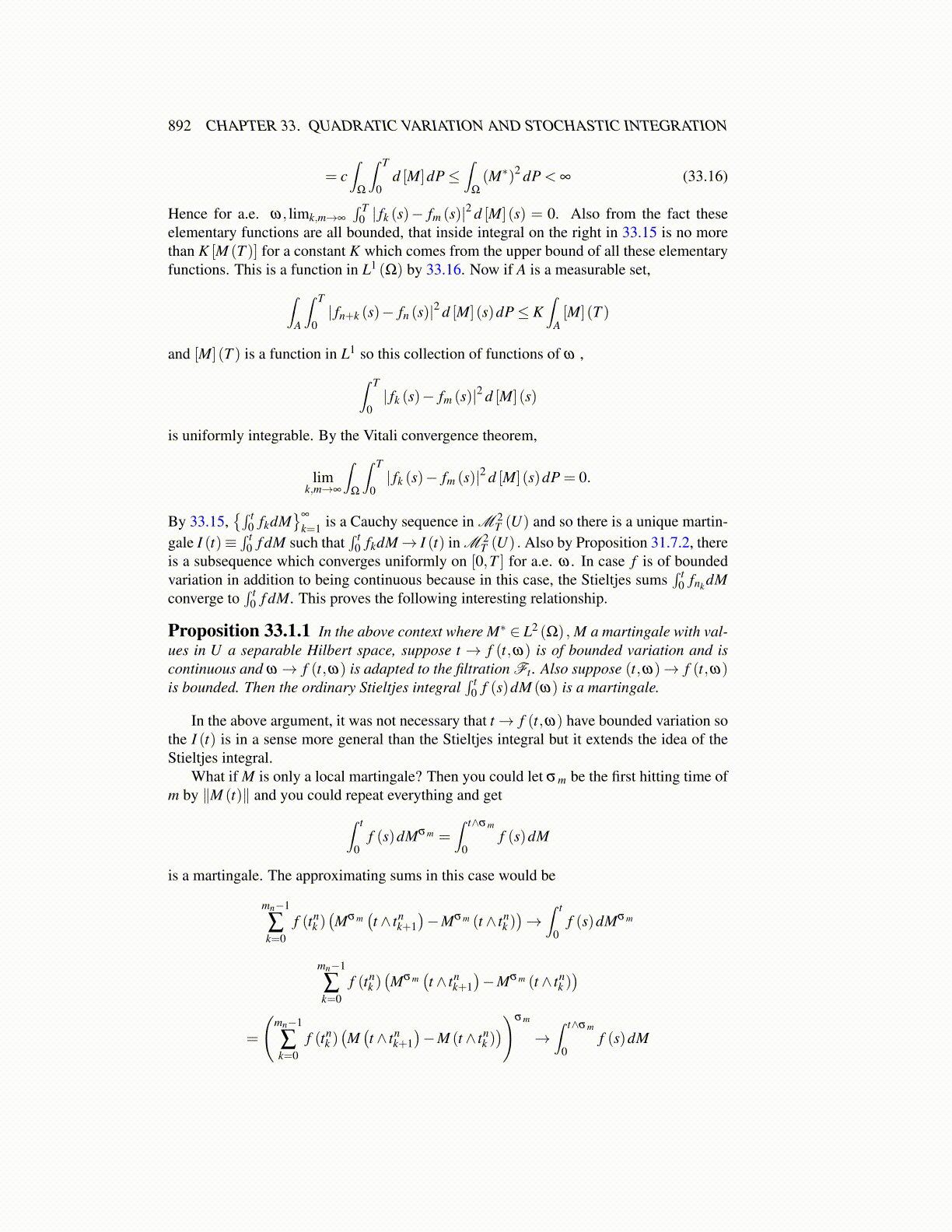
892 CHAPTER 33. QUADRATIC VARIATION AND STOCHASTIC INTEGRATION
= c∫
Ω
∫ T
0d [M]dP≤
∫Ω
(M∗)2 dP < ∞ (33.16)
Hence for a.e. ω, limk,m→∞
∫ T0 | fk (s)− fm (s)|2 d [M] (s) = 0. Also from the fact these
elementary functions are all bounded, that inside integral on the right in 33.15 is no morethan K [M (T )] for a constant K which comes from the upper bound of all these elementaryfunctions. This is a function in L1 (Ω) by 33.16. Now if A is a measurable set,∫
A
∫ T
0| fn+k (s)− fn (s)|2 d [M] (s)dP≤ K
∫A[M] (T )
and [M] (T ) is a function in L1 so this collection of functions of ω ,∫ T
0| fk (s)− fm (s)|2 d [M] (s)
is uniformly integrable. By the Vitali convergence theorem,
limk,m→∞
∫Ω
∫ T
0| fk (s)− fm (s)|2 d [M] (s)dP = 0.
By 33.15,{∫ t
0 fkdM}∞
k=1 is a Cauchy sequence in M 2T (U) and so there is a unique martin-
gale I (t)≡∫ t
0 f dM such that∫ t
0 fkdM→ I (t) in M 2T (U) . Also by Proposition 31.7.2, there
is a subsequence which converges uniformly on [0,T ] for a.e. ω . In case f is of boundedvariation in addition to being continuous because in this case, the Stieltjes sums
∫ t0 fnk dM
converge to∫ t
0 f dM. This proves the following interesting relationship.
Proposition 33.1.1 In the above context where M∗ ∈ L2 (Ω) , M a martingale with val-ues in U a separable Hilbert space, suppose t → f (t,ω) is of bounded variation and iscontinuous and ω→ f (t,ω) is adapted to the filtration Ft . Also suppose (t,ω)→ f (t,ω)is bounded. Then the ordinary Stieltjes integral
∫ t0 f (s)dM (ω) is a martingale.
In the above argument, it was not necessary that t→ f (t,ω) have bounded variation sothe I (t) is in a sense more general than the Stieltjes integral but it extends the idea of theStieltjes integral.
What if M is only a local martingale? Then you could let σm be the first hitting time ofm by ∥M (t)∥ and you could repeat everything and get∫ t
0f (s)dMσm =
∫ t∧σm
0f (s)dM
is a martingale. The approximating sums in this case would be
mn−1
∑k=0
f (tnk )(Mσm
(t ∧ tn
k+1)−Mσm (t ∧ tn
k ))→∫ t
0f (s)dMσm
mn−1
∑k=0
f (tnk )(Mσm
(t ∧ tn
k+1)−Mσm (t ∧ tn
k ))
=
(mn−1
∑k=0
f (tnk )(M(t ∧ tn
k+1)−M (t ∧ tn
k )))σm
→∫ t∧σm
0f (s)dM